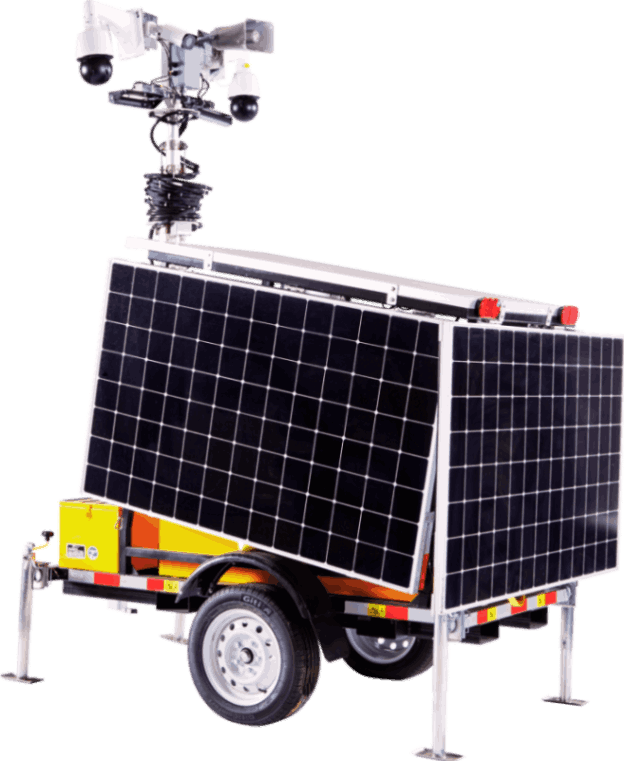Solar Camera Trailer: Off-Grid Security, Anywhere You Need It

Understand about Solar Camera Trailer?
A Solar Camera Trailer is a mobile, self-contained surveillance unit that uses solar panels and batteries to power high-definition cameras, lights, and communications equipment. Mounted on a towable trailer, it deploys in minutes and operates off-grid for weeks or months, delivering live video, alerts, and recorded evidence without trenching power or pulling network lines. It’s ideal for securing temporary, remote, or changing locations where traditional CCTV is impractical or too expensive.
Why Solar Camera Trailers Are Surging
Organizations across construction, critical infrastructure, logistics, and events need flexible, always-on visibility. A Solar Camera Trailer solves the core problems of time, cost, and coverage:
-
Rapid deployment: Arrives ready to tow, position, and power on.
-
Lower total cost: No utility hookup, trenching, or monthly generator fuel.
-
Reliable uptime: Solar charge plus battery storage for overnight and cloudy days.
-
Deterrence and response: Strobes, sirens, and live talk-down deter intruders before losses occur.
-
Scalability: Move it as the project evolves; add units to expand coverage.
-
Connectivity anywhere: Cellular, 5G, or satellite backhaul keeps video streaming and alerts flowing.
Know about Core Components and Features
When evaluating a Solar Camera Trailer, assess the full stack—not just the panel and camera:
-
Cameras: Fixed, panoramic, or PTZ for long-range zoom and tracking.
-
Analytics: Motion filters, human/vehicle detection, intrusion zones, and smart alerts to reduce false alarms.
-
Storage: Onboard NVR/SD with encrypted cloud backup for redundancy.
-
Power: High-efficiency solar array, MPPT charge controller, deep-cycle battery bank, and optional hybrid backup.
-
Connectivity: 4G/5G LTE, dual-SIM failover, and optional satellite for ultra-remote sites.
-
Deterrence: Loudspeaker for live talk-down, blue/red strobe, floodlights.
-
Build: Wind-rated mast (typically 15–30 feet), galvanized trailer, tamper detection, locking enclosures.
-
Management: Remote health monitoring, power telemetry, automatic reboot, and OTA firmware updates.
How a Solar Camera Trailer Works
-
Daytime: Solar panels produce energy, powering the system and recharging batteries.
-
Night/low sun: The system draws from batteries sized for the site’s load and climate.
-
Connectivity: Video streams to a cloud VMS or monitoring center; alerts push to supervisors or guards.
-
Response: Detections trigger siren/strobe, record clips, and notify responders for real-time talk-down.
-
Evidence: Footage is archived locally and/or in the cloud for investigations and compliance.
Top Use Cases
-
Construction sites: Protect materials, tools, and heavy equipment; document progress with time-lapse.
-
Utilities and infrastructure: Substations, pipelines, solar farms, wind sites, and water treatment facilities.
-
Logistics and retail: Overflow lots, trailer yards, seasonal pop-up locations, loss prevention perimeters.
-
Events and festivals: Crowd monitoring, access control, and vendor area protection.
-
Public safety: Temporary crime hot spots, traffic studies, disaster response staging areas.
-
Agriculture and remote land: Deter trespass, monitor gates, and track wildlife impact.
Diffrerciate Solar Trailer Rent vs Buy: What’s Right for You?
| Factor | Rent | Buy |
|---|---|---|
| Upfront Cost | Low | Higher |
| Deployment Speed | Fast | Fast (after purchase) |
| Duration | Best for short-term | Best for long-term |
| Maintenance | Included with provider | Owner responsibility |
| Customization | Limited | High |
| Total Cost Over Time | Higher for long projects | Lower for multi-year |
If your need is seasonal or project-based (e.g., 3–6 months), renting a Solar Camera Trailer often makes sense. For ongoing operations, ownership typically wins on cost and customization.
Power Sizing and Uptime Considerations
The reliability of a Solar Camera Trailer comes down to realistic power budgeting:
-
Load calculation: Sum camera wattage, networking gear, lights, and auxiliaries; consider peak vs continuous draw.
-
Autonomy: Target at least 2–4 days of battery autonomy for poor weather.
-
Climate: Cold reduces battery capacity; high heat affects electronics. Choose appropriate battery chemistry and enclosures.
-
Panel angle and shading: Optimize tilt for latitude and site; avoid shadows from cranes, fences, or trees.
-
Night usage: Limit overnight floodlighting or schedule it; leverage IR and low-light sensors to save power.
Deployment Best Practices
-
Site survey: Identify coverage zones, likely intrusion points, and sun exposure windows.
-
Placement: Position the Solar Camera Trailer for clear lines of sight and minimal glare at critical times.
-
Mast height: Balance field of view with detail; too high reduces facial and plate clarity.
-
Network health: Check cellular signal; add high-gain antennas or external routers if needed.
-
Camera tuning: Set analytics zones, sensitivity, and schedules to minimize false alerts from animals, flags, or traffic.
-
Security hardening: Lock the coupler, use wheel boots, geofence the unit, and enable tamper alarms.
-
Documentation: Establish retention periods, user roles, and incident workflows with your monitoring team.
Discuss for Compliance, Privacy, and Policy
-
Signage: Post visible notices indicating video surveillance and audio policies as required.
-
Data retention: Align with industry standards and local regulations for how long you keep footage.
-
Access control: Enforce least-privilege permissions and multi-factor authentication for remote access.
-
Privacy zones: Mask sensitive areas like neighboring properties or employee restrooms in mobile units near facilities.
Fact about Measuring ROI
A Solar Camera Trailer should pay for itself by reducing theft, delays, and guard hours:
-
Theft reduction: Compare pre/post incident rates and average loss value.
-
Response time: Measure alert-to-intervention time with live talk-down vs traditional patrols.
-
Labor offset: Replace or supplement overnight guard shifts with remote monitoring escalation.
-
Claims and safety: Document incidents, near misses, and compliance checks to lower insurance exposure.
-
Project efficiency: Use time-lapse and periodic snapshots to verify subcontractor progress and deliveries.
A simple model: If a site suffers one $15,000 theft event per quarter, preventing a single incident can cover months of rental or a significant portion of ownership costs.
Look Major Trends Shaping the Next Generation
-
Edge AI: On-device analytics for faster detection, fewer false alarms, and lower bandwidth use.
-
Multi-sensor fusion: Thermal imaging with visible light for reliable detection in darkness, dust, or fog.
-
Smart deterrence: Adaptive sirens and lights that escalate based on behavior and time of day.
-
5G and satellite: Greater uplink capacity for multi-camera 4K streams in rural areas.
-
Integrations: Tie the Solar Camera Trailer into access control, drones for first response, and mass notification systems.
How to Choose the Right Solar Camera Trailer
-
Coverage objectives: Detail what you must see and at what detail (faces, plates, make/model).
-
Power budget: Match panel and battery to your load and climate with documented autonomy.
-
Connectivity plan: Validate cell carriers, data plans, and any satellite needs.
-
Deterrence tools: Ensure strobe, siren, and talk-down meet your site’s risk profile.
-
Service model: Decide on rent vs buy, maintenance responsibilities, and monitoring support.
-
Proof of performance: Request demo footage at night, in motion, and during bad weather from the exact hardware.
Final Word
A Solar Camera Trailer gives you rapid, off-grid surveillance that moves with your priorities, deters crime before it happens, and delivers actionable visibility without infrastructure headaches. With the right power design, analytics, and deployment practices, it can become your most cost-effective security asset—protecting people, property, and schedules wherever the job takes you.








